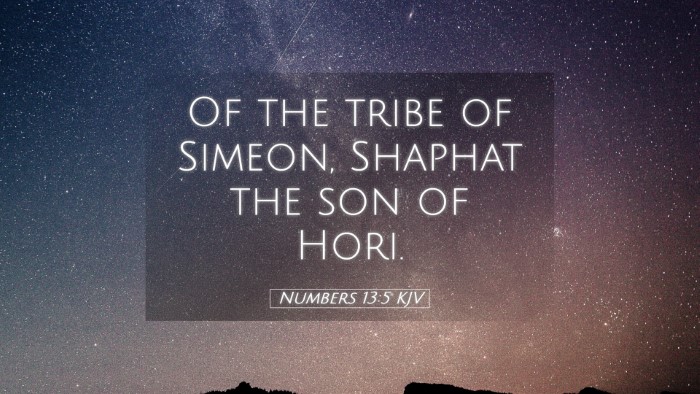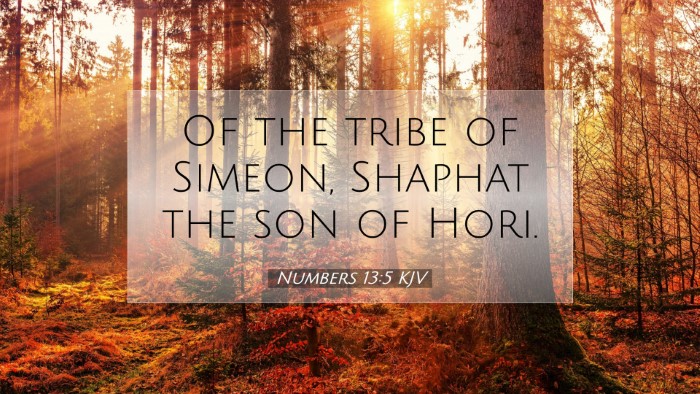Commentary on Numbers 13:5
Verse Reference: Numbers 13:5 - "Of the tribe of Simeon, Shaphat the son of Hori." (ESV)
Introduction
The verse contained in Numbers 13:5 serves as part of the narrative concerning the exploration of Canaan by the twelve spies sent by Moses. Each representative is crucial as they symbolize the tribes of Israel, underlining the collective identity and promise of God to His people. This commentary synthesizes insights from Matthew Henry, Albert Barnes, and Adam Clarke, offering a comprehensive understanding of the significance of Shaphat, the son of Hori, and his tribe's role in this pivotal moment in the history of Israel.
Historical Context
Numbers 13 is set during the Israelites' wandering in the desert, after their exodus from Egypt, and before their entrance into the Promised Land. It is imperative to recognize that these events are not merely historical; they provide theological insights into the nature of faith, obedience, and God's providence.
Moses' Leadership
Moses, acting on God's command, sends out leaders from each of the twelve tribes to gather intelligence about Canaan. This showcases Moses' role as a chosen leader who not only listens to God but also seeks to empower the tribes through a shared mission.
The Significance of Simeon
Shaphat, being identified as a representative from the tribe of Simeon, highlights certain aspects of this tribe's history and destiny. The tribe of Simeon is one of the twelve sons of Jacob, and their inheritance was located within the territory of Judah. This positioning is noteworthy, as it emphasizes the interconnectedness between the tribes.
Insights from Commentators
-
Matthew Henry:
Henry reflects on the choice of spies, emphasizing that their mission required men of valor and integrity. This is particularly relevant for Shaphat; as a representative, he not only bore the identity of Simeon but also the weight of leadership for his people.
-
Albert Barnes:
Barnes comments on the importance of Shaphat's inclusion among the spies, illuminating the faith required to explore the land of Canaan. He draws attention to the tribe of Simeon's historical challenges and their need for divine guidance as they confront the land of promise.
-
Adam Clarke:
Clarke notes the significance of the names in the genealogy presented in this passage. He posits that Shaphat, being described as the son of Hori, may indicate a lineage that signifies strength and reliability necessary for such an important task.
Theological Implications
The mention of Shaphat from the tribe of Simeon opens up rich theological discussions. Simeon’s history was marked by violence and strife, highlighted in Genesis 34. This background speaks to the redemptive work of God in reshaping the identities of Israel’s tribes through faith and collective journey toward the Promised Land.
Faith and Collective Identity
This selection of spies serves as a reminder of the communal aspect of faith. The inclusion of Shaphat reflects a move toward unity as each tribe is called to partake in the divine promise. Theologically, this can be perceived as an illustration of how God uses individuals from diverse backgrounds to fulfill His purposes across history.
Lessons for Leaders and Congregations
The verse and its context impart several vital lessons for pastors, students, theologians, and scholars:
-
The Role of Leaders:
Effective leaders are called to discernment and faithfulness. Moses' example invites leaders to seek and listen to God’s instructions and act courageously on behalf of their communities.
-
The Importance of Faith:
The exploration of Canaan represents both the challenges and the promises of faith. Leaders must instill courage within their communities to embrace God’s call and face the challenges ahead.
-
Unity in Diversity:
The representation of different tribes illustrates how diversity enriches the body of Christ. Each member's participation is vital for a complete understanding of God's mission.
Conclusion
Numbers 13:5 is a succinct yet profound verse that opens a window into Israel's history, leadership dynamics, and collective identity. Shaphat of Simeon stands as a symbol of the intertwining nature of heritage, faith, and communal destiny. As one reflects on the implications of this verse, it encourages an in-depth study of God’s faithfulness and the development of faith among His people.


